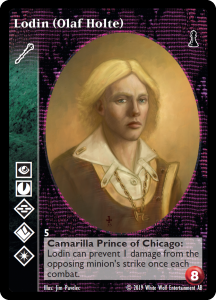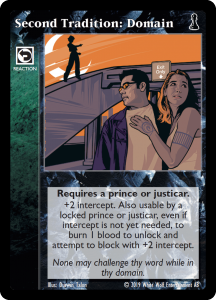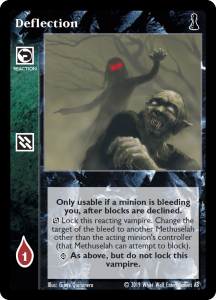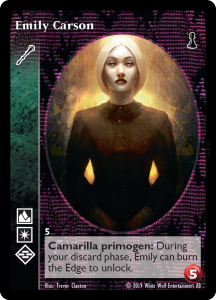
Overview
The First Blood: Ventrue introductory deck for Vampire: The Eternal Struggle focuses on heavily bleeding your prey with limited stealth and unblockability, on occasionally blocking potential threats and bruising your opponents in combat.
In the early game, bring out the highest capacity vampire in your uncontrolled region who has superior Dominate, so that, once in play, that vampire can play superior Govern the Unaligned to move 3 blood from the blood bank to a younger vampire in your uncontrolled region. By using your transfers wisely like this, you can get many vampires into play fast.
Once you have two or three vampires in play, start taking either your bleed actions (Govern the Unaligned or Dominate Kine) or your vampires’ inherent bleed actions to bleed your prey. If your prey attempts to block, play a Bonding action modifier to increase both stealth and bleed. Alternatively, play a Conditioning action modifier if your prey has declined to block. You cannot play Conditioning if you already played a Bonding (or vice-versa) during the same action.

Your access to unblockable actions comes from Daring the Dawn, an action modifier that ought to be played on very important actions, such as a bleed or political action that would oust your prey.
Another less dangerous way to get your actions through is via Misdirection. Use this master card to lock a minion controlled by your prey, so it is harder for your prey to block your actions this turn.
Your political actions can make your prey burn pool too. However, be mindful of how many votes each player has, because you may need the support of a cross-table player to make the referenda of your political actions succeed. Therefore, you may need to benefit that cross-table player somehow in order to get their support.
It is also worth mentioning that Ancilla Empowerment is a political action that should be used to oust your prey. Be careful, as it deals pool damage to the whole table.

Your defensive module is quite decent and based on limited access to intercept (Second Tradition: Domain), pool gain, bleed redirection and, in combat, damage prevention.
Your pool gain mainly comes from these cards and effects:
• Blood Doll: You can gain 1 pool per turn for each Blood Doll you control.
• Ousting your prey: You gain 6 pool when your prey is ousted.
Strategy tips
Given your limited access to intercept, it is highly advisable to block key actions only. For example, Sport Bike, Raven Spy, Charnas the Imp, Ivory Bow, political actions that deal pool damage to you, or bleed actions you cannot redirect.

If you have at least a Deflection in your hand during your minion phase, leave one vampire unlocked so that they can redirect any dangerous bleeds that come your way, unless you have enough On the Qui Vive reaction cards in your hand, which will allow you to wake and attempt to block and play reaction cards as if unlocked.
Note that playing Second Tradition: Domain during a bleed action will force you to block that action and you will not be allowed to play Deflection unless you fail to block.
If your predator is playing the First Blood: Malkavian deck and you have an unlocked vampire with permanent intercept and enough intercept reaction cards in your hand, have that vampire attempt to block any action your predator takes, so that they run out of stealth action modifier cards.
On the other hand, if your predator is playing the First Blood: Malkavian deck and you do not have any vampire with permanent intercept or enough intercept reaction cards in your hand, do not attempt to block any actions taken by your predator, so that they cannot play any stealth cards in hand and get their hand clogged with them.

When in combat, have one of your vampires get one Weighted Walking Stick (if they do not have one already) before range is determined, so that your vampire can strike for 2 damage at close range.
Even though your damage prevention module is quite decent, try to avoid it with Nosferatu and, especially, with Tremere vampires, since those cards cannot prevent blood from being stolen, because that is not considered to be damage.
You will rarely have a perfect hand, so good hand management is essential to increase your odds of winning. Therefore, when in doubt use a discard phase action to discard a card you do not need (usually stealth action modifier or combat cards).
Another factor you should take into account during your minion phase is the order of your actions. Since your resources are limited, have your vampires take the least important actions first and the most important ones last.
And finally, make sure everything you do brings you one step closer to victory. Be patient, and do not let your emotions interfere.

How to build a competitive deck with two First Blood: Ventrue decks
Since tournament legal Vampire: The Eternal Struggle decks consist of a minimum of 60 and a maximum of 90 library cards and a minimum of 12 crypt cards, you could combine two First Blood: Ventrue decks in order to build a competitive deck meeting both requirements. It could look like this:
Crypt: (12 cards)
2 Emily Carson
2 Graham Gottesman
2 Joao Bile
2 Lodin (Olaf Holte)
2 Mustafa the Heir
2 Victor Donaldson
Library: (85 cards)
4 Blood Doll
4 Misdirection
1 Uptown Hunting Ground
1 Ventrue Headquarters
2 Dominate Kine
12 Govern the Unaligned
2 Ancilla Empowerment
8 Kine Resources Contested
6 Bonding
4 Conditioning
2 Daring the Dawn
4 Seduction
4 Indomitability
4 Rolling with the Punches
2 Soak
4 Unflinching Persistence
6 Weighted Walking Stick
7 Deflection
4 On the Qui Vive
4 Second Tradition: Domain
Good luck playing the First Blood: Ventrue deck!
Note: This article can be downloaded with additional graphics in PDF format: How to play the First Blood: Ventrue deck

RELATED: How to play the First Blood: Malkavian deck
RELATED: How to play the First Blood: Nosferatu deck
RELATED: How to play the First Blood: Toreador deck
RELATED: How to play the First Blood: Tremere deck
Copyright © 2025 Paradox Interactive AB. www.paradoxinteractive.com. All rights reserved. Vampire: The Eternal Struggle and Vampire: The Masquerade® are trademarks and/or registered trademarks of Paradox Interactive AB. All rights reserved.
